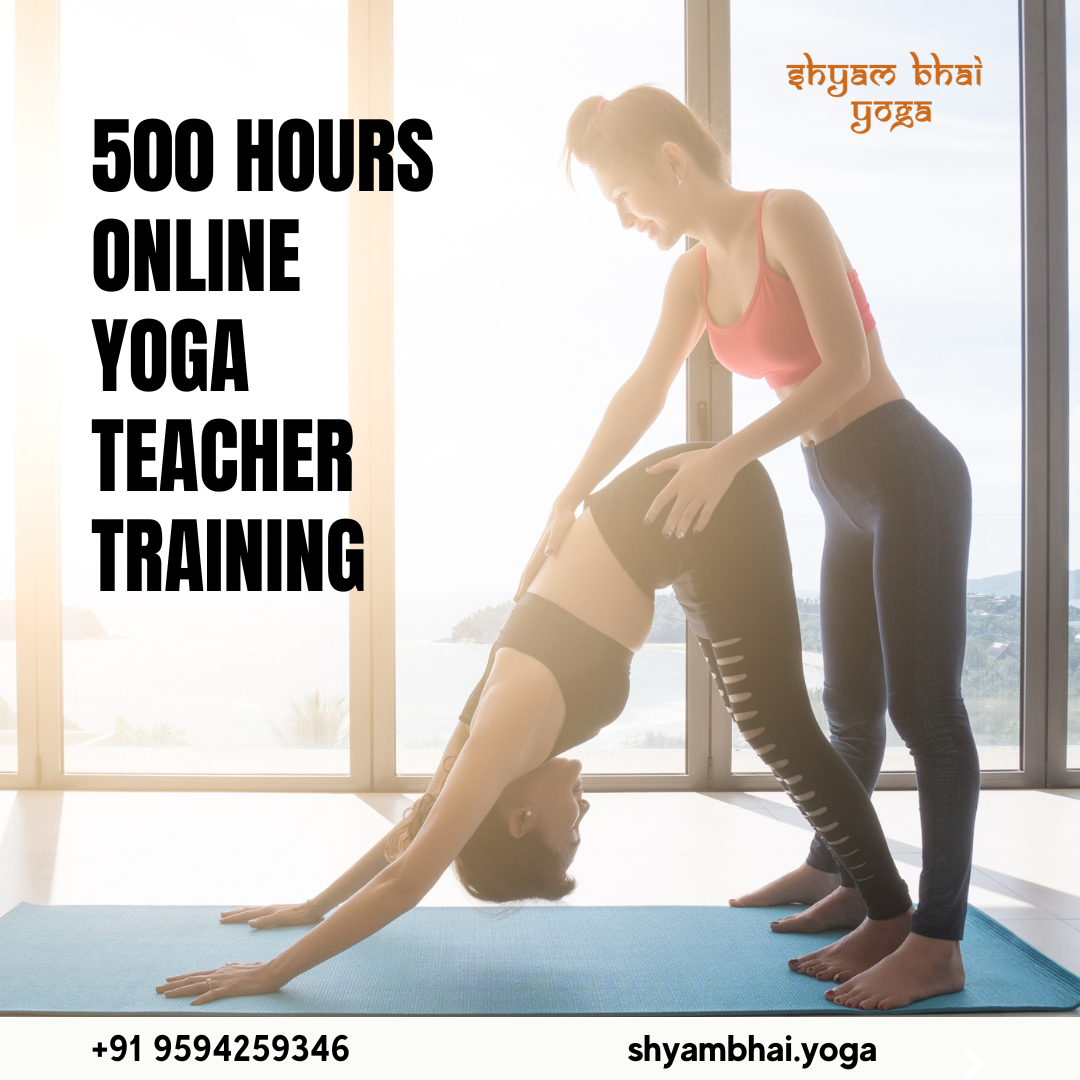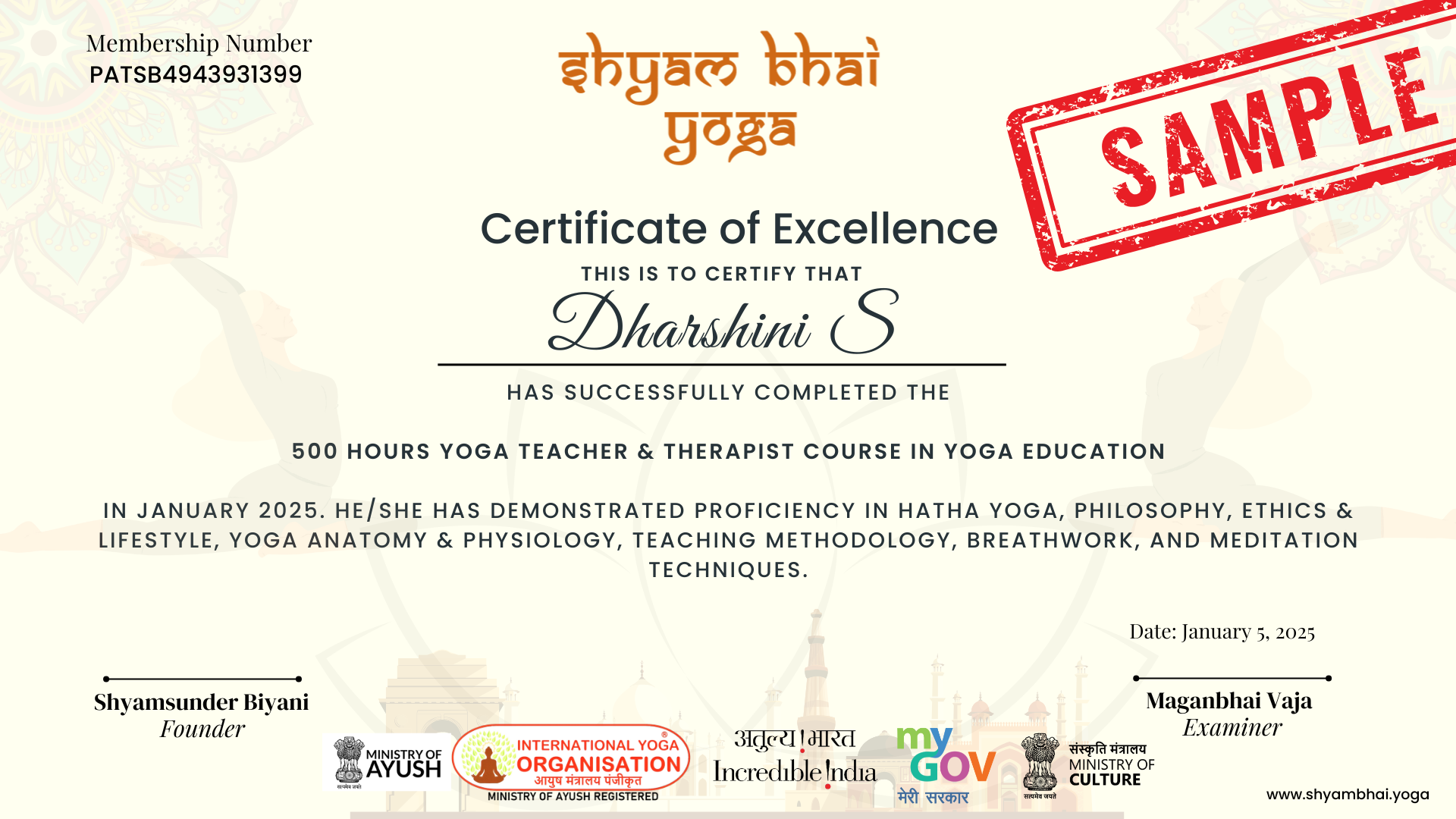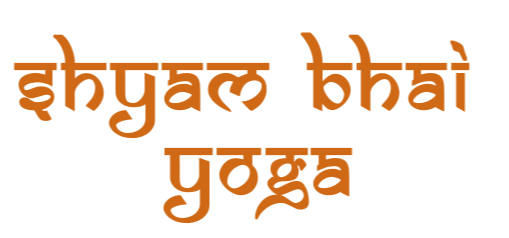500 Hours Online Yoga Teacher Training Course
Join Shyambhai’s 500-Hour Online Yoga Teacher Training for a profound, home-based learning experience. Perfect for serious practitioners, aspiring yoga therapists, and teachers, this program blends advanced practice with deep philosophy. Invest Rs. 28,999 to elevate your skills, gain certification, and transform your personal and professional yoga journey.
Why Choose Shyambhai Yoga Certification?
🌟 Interactive daily sessions
🌟 Immersive at-home learning experience
🌟 Adaptable schedule to fit your life
🌟 Intimate class sizes for personal attention
🌟 Official YCB (Yoga Certification Board) certification
🌟 Expert-led teaching methodology

500 Hours Yoga Teacher Training Course (YTT) curriculum
Embark on a comprehensive journey into yoga with our expertly designed 500 -Hour YTT program. Our curriculum, developed by master practitioners, provides a solid foundation in both the practical and philosophical aspects of yoga. Whether you aspire to teach or deepen your personal practice, this program delivers the essential tools for your yogic journey.
Our curriculum includes:
Unit 1: Introduction to Yoga and Yogic Practices
1.1 Yoga: Etymology, definitions (Patanjala Yoga Sutra, Bhagwad Gita & Kathopanishad), aim, objectives and misconceptions.
1.2 Yoga: Its origin, history and development.
1.3 Brief Introduction to Samkhya and Yoga Darshana.
1.4 Life sketches and teachings of Yoga masters (Maharishi Ramana, Shri Aurobindo Swami Vivekananda, Swami Dayananda Saraswati).
1.5 Principles of Yoga and practices of healthy living.
1.6 Principles and Practices of Jnana Yoga.
1.7 Principles and Practices of Bhakti Yoga.
1.8 Principles and Practices of Karma Yoga.
1.9 Concept and principles of Sukshma Vyayama, Sthula Vyayama, Surya Namaskara and their significance in Yoga Sadhana.
1.10 Concept and principles of Shatkarma: Meaning, Types, Principles and their significance in Yoga Sadhana.
1.11 Concept and principles of Yogasana: Meaning, definition, types and their significance in Yoga Sadhana.
1.12 Concept and principles of Pranayama: Meaning, definition, types and their significance in Yoga Sadhana.
1.13 Introduction to Tri Bandha and their health benefits.
1.14 Dhyana and its significance in health and well being.
1.15 Introduction to Yogic relaxation techniques with special reference to Yoga Nidra.
Unit 2: Introduction to Yoga Texts
2.1 Introduction to Prasthanatrayee, Purushartha Chatushtaya and goal of human life.
2.2 Yoga in Kathopnishad, Prashanopanisha, Tattriyopnishad with special emphasis on Panchakosha Vivek and Ananda Mimamsa.
2.3 Concept of Sthitaprajna, Bhakti, Karma and Dhyana in Bhagavad Gita.
2.4 Significance of Bhagavad Gita in day to day life.
2.5 Concept of healthy living in Bhagavad Gita (Ahara, Vihara, Achara, Vichara).
2.6 Study of Patanjal Yoga Sutra including selected sutras from following chapters (I- 1 to 12, II-46 – 51, III- 1 to 4).
2.7 Concept of Chitta, Chitta Bhumi, Chitta Vritti, Chitta Vikshepa, Chittaprasadanam and their relationship with wellness.
2.8 Bahiranga Yoga of Maharishi Patanjali (Yama, Niyama, Asana, Pranayama, Pratyahara).
2.9 Antaranga Yoga of Maharisi Patanjali (Dharana, Dhyana, Samadhi).
2.10 Concept of mental well being according to Patanjala Yoga.
2.11 Hatha Yoga: Its parampara, knowledge of basic Yoga texts (Hatha Pradipika and Gherand Samhita). Relationship between Hatha yoga and Raja Yoga.
2.12 Sadhaka and Badhaka tatva, principle to be followed by Hatha Yoga practitioner.
2.13 Concept of Matha, Mitahara, Pathya & Apthaya.
2.14 Concepts of Nadis, Prana and Pranayama for Subjective experiences.
2.15 Knowledge of Hatha Yoga practices for wellness (Shatkarma, Asanas, Pranayama, Mudra, Nadaanusandhana).
Unit 3: Yoga for Wellness
3.1 General introduction to human body and nine major systems of human body.
3.2 Introductions to sensory organs (Eyes, Nose, Ears, Tongue and Skin).
3.3 Basic functions of nine major systems of human body and homeostasis.
3.4 Yogic concept of health and wellness.
3.5 Concept of Tridoshas, Sapta Dhatu, Agni, Vayu and Mala; their role in wellness.
3.6 Concepts of Dinacharya and Ritucharya and their importance in well being.
3.7 Importance of Ahara, Nidra and Brahmacharya in well being.
3.8 Yogic concept of mental hygiene: Maitre, Karuna, Mudita & Upeksha).
3.9 Importance of psychosocial environment for health and wellness.
3.10 Yogic concept and principles of Ahara(Mitahara, Yuktahara).
3.11 Health benefits of Suryanamaskara, Shatkarma, Asanas, Pranayama and practices leading to Dhyana (as per the practical syllabus of the course).
3.12 Salient features and contra indications of Yoga practices for well being (as per the practical syllabus of the course).
3.13 Knowledge of common diseases; their prevention and management by Yoga.
3.14 Knowledge of role of Yoga in the management of non communicable diseases.
3.15 Concept of stress and Yogic management of stress and its consequences.
Unit 4: Practical (Part A)
- Prayer
1.1 Concept and Recitation of Pranava
1.2 Concept and Recitation of Hymns
1.3 Selected universal prayers, invocations and Nishpatti Bhava
- Yogic Shat Karma
2.1 Neti: Sutra Neti and Jala Neti
2.2 Dhauti: Vamana Dhauti (Kunjal)
2.3 Kapalabhati (Vatakrama)
- Yogic Sukshma Vyayama and Sthula Vyayama
A. Yogic Sukshma Vyayama (Micro circulation practices)
– Neck Movement
– Griva Shakti Vikasaka (I,II,III,IV)
– Shoulder Movement
– Bhuja Valli Shakti Vikasaka
– Purna Bhuja Shakti Vikasaka
– Trunk Movement
– Kati Shakti Vikasaka (I, II, III, IV, V)
– Knee Movement
– Jangha Shakti Vikasaka (II-A&B)
– Janu Shakti Vikasaka
– Ankle movement
– Pada-mula shakti Vikasaka-A&B
– Gulpha-pada-pristha-pada-tala shakti Vikasaka
B. Yogic Sthula Vyayama (Macro circulation practices)
– Sarvanga Pushti
– Hrid Gati (Engine daud)
- Yogic Surya Namaskara with Mantra
- Yogasana
5.1 Tadasana, Hastottanasana, Vrikshasana
5.2 Ardha Chakrasana, Padahastasana
5.3 Trikonasana, Parshva Konasana, Katichakrasana
5.4 Dandasana, Padmasana, Vajarasana
5.5 Yogamudrasana, Parvatasana
5.6 Bhadrasana, Mandukasana, Ushtrasana, Shashankasana, Uttana Mandukasana
5.7 Paschimottanasana, Purvottanasana
5.8 Vakrasana, Ardha Matsyendrasana, Gomukhasana
5.9 Makarasana, Bhujangasana, Shalabhasana, Dhanurasana
5.10 Pavanamuktasana and its variations
5.11 Uttanapadasana, Ardha Halasana, Setubandhasana, Sarala-Matsyasana
5.12 Shavasana
- Preparatory Breathing Practices
6.1 Sectional Breathing (Abdominal, Thoracic and Clavicular Breathing)
6.2 Yogic Deep Breathing
6.3 Anuloma Viloma/Nadi Shodhana
- Pranayama
7.1 Concept of Puraka, Rechaka and Kumbhaka
7.2 Ujjayee Pranayama (Without Kumbhaka)
7.3 Sheetalee Pranayama (Without Kumbhaka)
7.4 Sitkaree Pranayama (Without Kumbhaka)
7.5 Bhramaree Pranayama (Without Kumbhaka)
- Concept and Demonstration of Bandha
8.1 Jalandhara Bandha
8.2 Uddiyana Bandha
8.3 Mula Bandha
- Concept and Demonstration of Mudra
9.1 Yoga Mudra
9.2 Maha Mudra
9.3 Vipareetakarani Mudra
- Practices leading to Dhyana Sadhana
10.1 Body awareness and Breath awareness
10.2 Yoga Nidra
10.3 Antarmauna
10.4 Recitation of Pranava and Soham
10.5 Recitation of Hymns
10.6 Practice of Dhyana
Unit 4: Practical (Part B)
B. Teaching Skills (Methods of Teaching Yoga)
1.1 Teaching methods with special reference to Yoga
1.2 Factors influencing Yoga teaching
1.3 Need of teaching practice and its use in Yogic practice
1.4 Teaching Aids: Meaning and Need, Role of Language, Voice, Fluency, Clarity and Body language in an ideal presentation
1.5 Methods of teaching Yoga to an individual, small group and large group
1.6 Lecture cum demonstration in Yoga: Its meaning, importance and method of its Presentation
1.7 Lesson plan: Its meaning and need
1.8 Preparation of lesson plan in Yoga, Preparation of lesson plan for an individual and for a group
1.9 Presentation of lessons in specific Yogic practices: Kriya, Asana, Pranayama, and Dhyana
1.10 Assessment of a Yoga class (detection and correction of mistakes)
Eligibility for the Course
✅ This advanced certification welcomes yoga practitioners who have completed a 200-hours online yoga teacher training certification or equivalent. Ideal candidates should have at least 2 years of consistent yoga practice. Open to participants aged 18 and above. Upon completion, you’ll receive advanced certification recognized by the Yoga Certification Board (YCB), enabling you to teach specialized yoga programs globally. For a higher level of yoga training, you can also join 900 hours online yoga teacher training.
Learning Medium
✅ Expert instruction delivered in both Hindi and English
✅ Comprehensive digital learning materials and resources
✅ Interactive live sessions via Zoom platform
✅ Exclusive access to recorded sessions for review
✅ Bi-weekly masterclasses and in-depth topic reviews
✅ Personal mentoring sessions
✅ Access to private online learning community
✅ Secure, individual login credentials provided via WhatsApp
✅ Flexible make-up sessions for missed classes
Certification and Teaching Eligibility
✅ Official YCB-authorized advanced level certification
✅ Specialized teaching credentials in therapeutic applications
✅ Recognition as an advanced yoga educator
✅ Qualification for higher-level teaching positions
✅ Authorization to conduct teacher training programs
✅ Eligibility to offer specialized workshops and retreats
Career Opportunities
As a 500-hour certified yoga teacher, you can:
✅ Establish your own yoga studio or teacher training programs
✅ Offer specialized therapeutic yoga sessions
✅ Lead advanced workshops and retreats internationally
✅ Design corporate wellness programs
✅ Develop specialized programs for healthcare facilities
✅ Create online yoga content and courses
✅ Conduct private coaching for advanced practitioners
✅ Specialize in specific yoga styles or populations
✅ Partner with wellness centers and luxury resorts
✅ Pursue yoga therapy and rehabilitation opportunities
Key Benefits of Our 500 Hours Yoga Teacher Training Course (YTT)
Advanced Teaching Mastery
Earn prestigious YCB-certified qualification recognized worldwide. Move beyond basic teaching to master advanced techniques, specialized adjustments, and therapeutic applications. Command higher rates and access premium teaching positions.
Therapeutic Expertise
Master therapeutic yoga applications and advanced anatomy. Learn to work with special populations, design rehabilitation programs, and address specific health conditions. Expand your practice into wellness centers and medical facilities.
Deep Spiritual Understanding
Immerse yourself in advanced meditation, traditional philosophy, and Sanskrit studies. Develop authentic teaching methods rooted in ancient wisdom. Transform your personal practice while guiding others effectively.
Flexible Online Learning
Balance your training with daily life through interactive live sessions and recorded classes. Receive personalized mentoring from expert teachers while studying from anywhere in the world.
Enhanced Career Opportunities
Launch your own studio, conduct workshops, lead retreats, and create specialized programs. Develop business skills to build a thriving yoga career with multiple income streams globally.
What to Expect from a 500-hour Yoga Teacher Training Course?
If you’re considering the 500-hour yoga teacher training course with Shyambhai Yoga, prepare for an even deeper and more transformative journey! Our extensive online program is crafted to elevate your practice and teaching skills beyond the basics, giving you a profound understanding of advanced yoga techniques and philosophies.
Over the course of 500 hours, you’ll explore advanced asanas (postures), in-depth pranayama (breathwork), meditation practices, and the subtleties of yoga philosophy. Our seasoned instructors will guide you through a hands-on learning experience that covers the complex layers of the practice, including anatomy, yoga therapy, and alignment techniques tailored for a range of body types and needs.
This training goes beyond foundational concepts, diving into the rich history and traditions of yoga, as well as specialized practices like Ayurveda and therapeutic yoga. You’ll refine your ability to sequence classes creatively and adapt them for diverse student groups. Alongside physical techniques, the course will help you cultivate advanced skills in communication and student engagement, empowering you to connect more deeply with your students.
By the end of this immersive 500-hour program, you’ll emerge with the expertise and confidence to lead your students through more advanced practices and support their personal growth, while continuing your own journey of self-discovery. At Shyambhai Yoga, we believe in fostering a supportive, nurturing environment where you can flourish as both a practitioner and teacher.
So, if you’re ready to take your yoga journey to the next level, join us with an open heart, and prepare to dive deep into the beauty and wisdom of yoga. We look forward to welcoming you to our vibrant Shyambhai Yoga community!
Sample Certification

After teaching yoga for 2 years, I wanted to upgrade my skills. This 500-hour course was just what I needed to shine. I learned so much about therapeutic yoga and healing. The advanced lessons helped me design unique class flows. Now, my students say my classes are way more exciting!
I was running my own yoga studio, but something felt missing. This course gave me all the knowledge I needed. The business tips helped me double my studio income! I also learned how to train other teachers and plan amazing retreats. Best investment I’ve made in my yoga career!
Just finished my 500 hours and wow, what a journey! The hands-on practice through Zoom was surprisingly effective. Teachers spot the tiniest alignment issues even through the screen. The personal feedback sessions were incredibly detailed. I’m now confident handling students!
